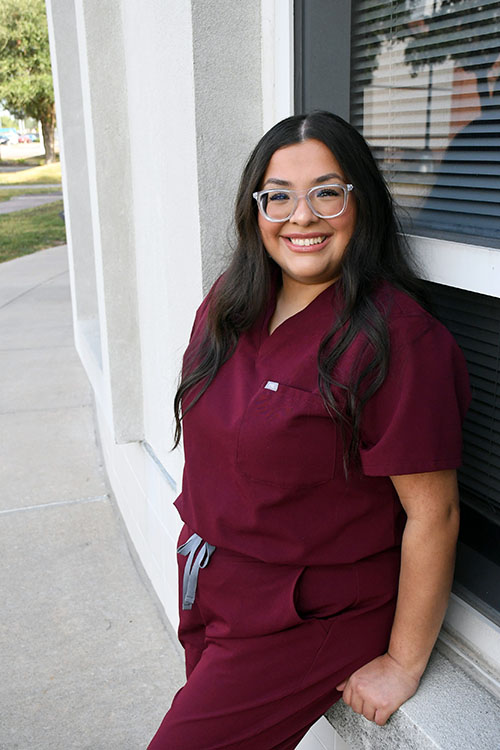Helper mindset lands alumna in operating room

From childhood, Ashley Arratia pictured one job in her future, and it involved a uniform. Scrubs, to be exact.
Shadowing her mom at her hospital job, the 5-year-old would imagine herself as one of the nurses. At home, her Barbie dolls would check each other’s temperatures and give shots.
“That’s all I’ve wanted to do is just help people,” Arratia said.
Today she does indeed wear scrubs, but she wound up in a field that suits her even better than nursing.
Pandemic pivot

“I just didn’t have the spark for nursing anymore,” she said.
It was time to pivot, but how? Since the fast-paced operating room had always fascinated her, surgical technology seemed a better fit: She could enter the health care field quickly and work alongside surgeons.
In August 2022, Arratia started San Jac’s three-semester surgical technology program.
Immediately, she learned the importance of maintaining a sterile environment — from preparing a sterile field for surgery to passing instruments to surgeons.
“A big component of the operating room is sterility,” she said. “That’s probably one of the hardest concepts to grasp: ‘OK, you can’t touch this, but you can touch this.’”
Operating room 101
While the program’s instructors and labs laid a solid foundation, Arratia enjoyed putting her skills to the test in hospital clinicals, which began halfway through her first semester.
“You get thrown in there really fast, which is a good thing, because I believe in this career you don’t really learn unless you’re hands-on,” she said.
In the operating room, the biggest challenge Arratia faced was her own self-doubt — “understanding I was new and it’s going to take time to learn everything.” During her first surgery experience at a teaching hospital, the doctors encouraged her to jump in.
“You can do it,” one surgeon told her. “Count the instruments, call out for supplies, and be confident while doing so.”
Despite being a scared first-semester student, Arratia felt supported throughout that first clinical.
“I definitely had those days where I left bawling because it was hard mentally,” she said. “But my clinical instructor Mackinze Goodman Martin was always there and had such encouraging words every single day.”
Lifelong learner
In summer 2023, Arratia was finishing her last clinical. When she walked inside the Woman’s Hospital of Texas, something clicked.
“I loved that place — the people, the specialties of surgery, the management, and the environment,” she said. “Everybody was so willing to teach you, even the doctors.”
Surgical technology is an amazing field to go into. You’re constantly learning something new every day.
Before Arratia graduated, the Woman’s Hospital had offered her a job. For the past year, she has been working as a certified surgical technologist there.
Each day holds growth opportunities galore — from working with different surgeons to learning different specialties and surgeries.
“Surgical technology is an amazing field to go into,” she said. “You’re constantly learning something new every day.”
After three or four years, she hopes to train for the next step: becoming a surgical first assistant.
Mission accomplished
Arratia went into surgical technology hoping for a less demanding role than nursing, but she hasn’t escaped the go-go-go pace. She might be on her feet for an entire 10-hour shift with barely time to sip water or munch on chips.
In those moments, she remembers why she pursued this field — to help people.
“We’re going to take such good care of you,” she says, smiling and squeezing a patient’s hand before surgery.
Some patients say “thank you” or smile back before drifting off under anesthesia. Then the hard work begins.
“The most rewarding part of the job is knowing you’re helping the patients,” she said. “You’re able to be a part of fixing something that’s wrong with them.”
